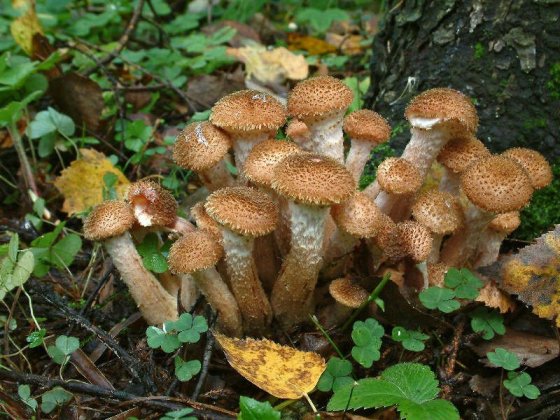The honey mushroom is recognized as the largest living organism in the world. Or rather, not he himself, but his mycelium, which amazes even experienced mushroom pickers and biologists with its parameters. This giant creature grows in the Malheur Wildlife Refuge in eastern Oregon (USA). Its territory covers about 1,000 hectares; about 1,600 football fields could fit on it. The weight of the mycelium Humongous Fungus subspecies Armillaria ostoyae exceeds 600 tons, and its age is more than 2500 years.
Scientists have dubbed the black honey fungus the Oregon monster not at all because of its fantastic parameters, but because of the colossal damage that the parasitic fungus causes to surrounding vegetation. Fungal tentacles, the so-called rhizomorphs, spread underground over vast distances, entangle the roots of trees and secrete enzymes that dig into the bark of the plant and suck out all the nutrients from it.
Even some centuries-old oak trees of the reserve could not resist under the deadly tentacles of this giant octopus. The massive death of vegetation forced mycologists to look for the cause of the disaster. This is how the Oregon monster was discovered, which, according to experts, is capable of deforesting the territory under its control in a couple of years.
It was thanks to the massive death of trees that the giant was identified. Attracted by the history of the death of trees, biologists in 1998 were able to determine that the honey fungus mycelium from Oregon is not individual clusters growing throughout the forest, but a gigantic, integral living organism. Previously, the largest living creature in the world was considered the mycelium of the dark honey fungus, growing in Washington state. Its size was estimated at 600 hectares.

The mycelium of the honey fungus does not just parasitize the root system of plants. Thanks to rhizomorphs (a kind of threads), the mycelium penetrates under the bark of a tree and can grow tens of meters in it, thereby feeding its mushrooms with useful substances. Such exploitation by a foreign organism kills the tree. Mushrooms belong to a separate kingdom; they are neither plants nor animals; they contain particles of both. However, mushrooms are still closer to animals than to plants. It is possible that there are larger myceliums on our planet, the existence of which is still unknown to scientists.
Beneath every forest there is a kind of Internet – a complex underground network of interconnected roots, fungi and bacteria. These organisms are often related to each other through symbiosis – for example, fungi and bacteria help plants absorb useful organic and inorganic substances from the soil, and also fix carbon dioxide and nitrogen from the atmosphere.
Symbionts come in several different types. Some, arbuscular mycorrhizal fungi, can penetrate mycelium threads between plant cells or even into the cells themselves. The roots of the plant practically do not change, and such symbionts can only be detected under a microscope. Others, ectomycorrhizal, entwine the root with a dense network of their threads and can penetrate into the interlacular space, but not into the cells. Still others enter into symbiosis with plants of only one family. Finally, another type of symbionts, nitrogen-fixing bacteria, are able to capture nitrogen from the atmosphere and enrich the soil with it.
The growth of mycelium, consisting of thin filaments, is not associated with a change in the ratio of mass to surface through which the mycelium receives water and nutrients. And gigantism, as well as longevity, are justified from the point of view of the mycelium. If its area is large, it becomes not subject to the vicissitudes of fate. While in one place the trees die and rot, providing food for the fungus, in others the mycelium waits for the forest to grow again.





